Discover 35 hidden attractions, cool sights, and unusual things to do in London (United Kingdom). Don't miss out on these must-see attractions: Palace of Westminster, Tower of London, and Kew Gardens. Also, be sure to include Westminster Abbey in your itinerary.
Below, you can find the list of the most amazing places you should visit in London (England).
Table of Contents
Palace of Westminster
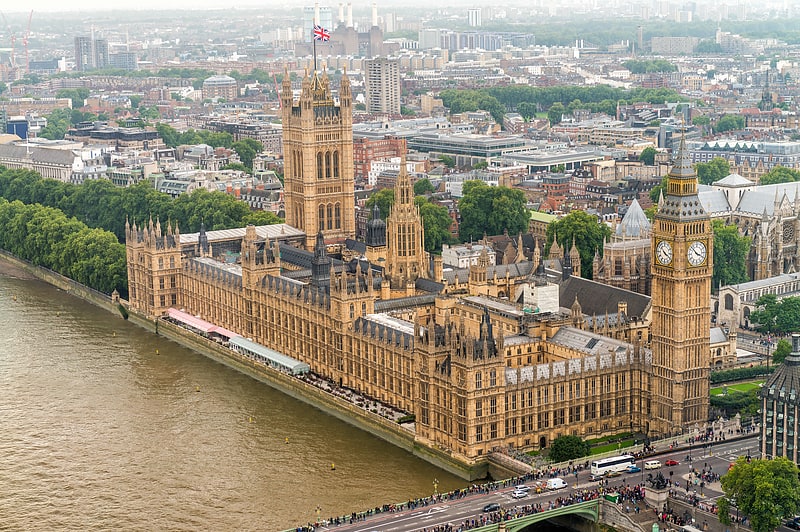
Iconic home of UK parliament. The Palace of Westminster serves as the meeting place for both the House of Commons and the House of Lords, the two houses of the Parliament of the United Kingdom. Informally known as the Houses of Parliament, the Palace lies on the north bank of the River Thames in the City of Westminster, in central London, England.
Its name, which derives from the neighbouring Westminster Abbey, may refer to several historic structures but most often: the Old Palace, a medieval building-complex largely destroyed by fire in 1834, or its replacement, the New Palace that stands today. The palace is owned by the monarch in right of the Crown and, for ceremonial purposes, retains its original status as a royal residence. Committees appointed by both houses manage the building and report to the Speaker of the House of Commons and to the Lord Speaker.
The first royal palace constructed on the site dated from the 11th century, and Westminster became the primary residence of the Kings of England until fire destroyed the royal apartments in 1512 (after which, the nearby Palace of Whitehall was established). The remainder of Westminster continued to serve as the home of the Parliament of England, which had met there since the 13th century, and also as the seat of the Royal Courts of Justice, based in and around Westminster Hall. In 1834 an even greater fire ravaged the heavily rebuilt Houses of Parliament, and the only significant medieval structures to survive were Westminster Hall, the Cloisters of St Stephen's, the Chapel of St Mary Undercroft, and the Jewel Tower.
In the subsequent competition for the reconstruction of the Palace, the architect Charles Barry won with a design for new buildings in the Gothic Revival style, specifically inspired by the English Perpendicular Gothic style of the 14th–16th centuries. The remains of the Old Palace (except the detached Jewel Tower) were incorporated into its much larger replacement, which contains over 1,100 rooms organised symmetrically around two series of courtyards and which has a floor area of 112,476 m2 (1,210,680 sq ft). Part of the New Palace's area of 3.24 hectares (8 acres) was reclaimed from the River Thames, which is the setting of its nearly 300-metre long (980 ft) façade, called the River Front. Augustus Pugin, a leading authority on Gothic architecture and style, assisted Barry and designed the interior of the Palace. Christian themes were integrated into the design. Construction started in 1840 and lasted for 30 years, suffering great delays and cost overruns, as well as the death of both leading architects; works for the interior decoration continued intermittently well into the 20th century. Major conservation work has taken place since then to reverse the effects of London's air pollution, and extensive repairs followed the Second World War, including the reconstruction of the Commons Chamber following its bombing in 1941.
The Palace is one of the centres of political life in the United Kingdom; "Westminster" has become a metonym for the UK Parliament and the British Government, and the Westminster system of government commemorates the name of the palace. The Elizabeth Tower, in particular, often referred to by the name of its main bell, Big Ben, has become an iconic landmark of London and of the United Kingdom in general, one of the most popular tourist attractions in the city, and an emblem of parliamentary democracy. Tsar Nicholas I of Russia called the new palace "a dream in stone". The Palace of Westminster has been a Grade I listed building since 1970 and part of a UNESCO World Heritage Site since 1987.[1]
Address: Parliament Square, SW1A 0AA London (City of Westminster)
Tower of London
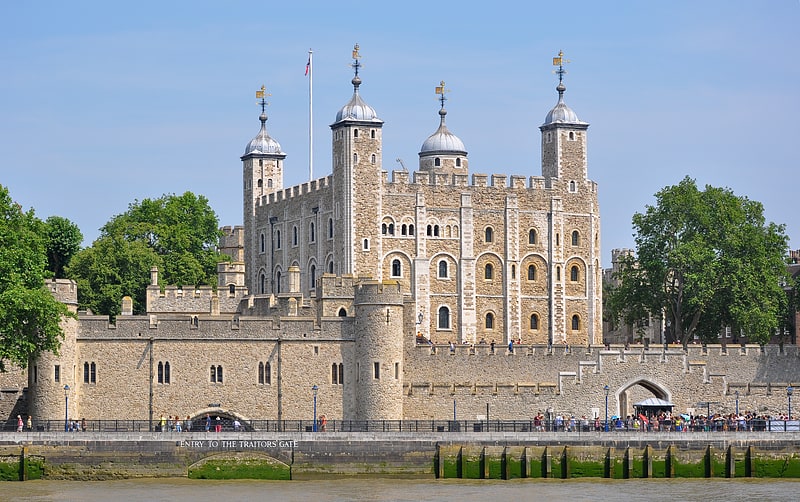
Medieval castle housing the Crown Jewels. The Tower of London, officially Her Majesty's Royal Palace and Fortress of the Tower of London, is a historic castle on the north bank of the River Thames in central London. It lies within the London Borough of Tower Hamlets, which is separated from the eastern edge of the square mile of the City of London by the open space known as Tower Hill. It was founded towards the end of 1066 as part of the Norman Conquest. The White Tower, which gives the entire castle its name, was built by William the Conqueror in 1078 and was a resented symbol of oppression, inflicted upon London by the new ruling elite. The castle was also used as a prison from 1100 until 1952, although that was not its primary purpose. A grand palace early in its history, it served as a royal residence. As a whole, the Tower is a complex of several buildings set within two concentric rings of defensive walls and a moat. There were several phases of expansion, mainly under kings Richard I, Henry III, and Edward I in the 12th and 13th centuries. The general layout established by the late 13th century remains despite later activity on the site.
The Tower of London has played a prominent role in English history. It was besieged several times, and controlling it has been important to controlling the country. The Tower has served variously as an armoury, a treasury, a menagerie, the home of the Royal Mint, a public record office, and the home of the Crown Jewels of England. From the early 14th century until the reign of Charles II in the 17th century, a procession would be led from the Tower to Westminster Abbey on the coronation of a monarch. In the absence of the monarch, the Constable of the Tower is in charge of the castle. This was a powerful and trusted position in the medieval period. In the late 15th century, the Princes in the Tower were housed at the castle when they mysteriously disappeared, presumed murdered. Under the Tudors, the Tower became used less as a royal residence, and despite attempts to refortify and repair the castle, its defences lagged behind developments to deal with artillery.
The zenith of the castle's use as a prison was the 16th and 17th centuries, when many figures who had fallen into disgrace, such as Elizabeth I before she became queen, Sir Walter Raleigh, and Elizabeth Throckmorton, were held within its walls. This use has led to the phrase "sent to the Tower". Despite its enduring reputation as a place of torture and death, popularised by 16th-century religious propagandists and 19th-century writers, only seven people were executed within the Tower before the World Wars of the 20th century. Executions were more commonly held on the notorious Tower Hill to the north of the castle, with 112 occurring there over a 400-year period. In the latter half of the 19th century, institutions such as the Royal Mint moved out of the castle to other locations, leaving many buildings empty. Anthony Salvin and John Taylor took the opportunity to restore the Tower to what was felt to be its medieval appearance, clearing out many of the vacant post-medieval structures.
In the First and Second World Wars, the Tower was again used as a prison and witnessed the executions of 12 men for espionage. After the Second World War, damage caused during the Blitz was repaired, and the castle reopened to the public. Today, the Tower of London is one of the country's most popular tourist attractions. Under the ceremonial charge of the Constable of the Tower, and operated by the Resident Governor of the Tower of London and Keeper of the Jewel House, the property is cared for by the charity Historic Royal Palaces and is protected as a World Heritage Site.[2]
Address: Tower Hill, EC3N 4DR London (Tower Hamlets)
Kew Gardens
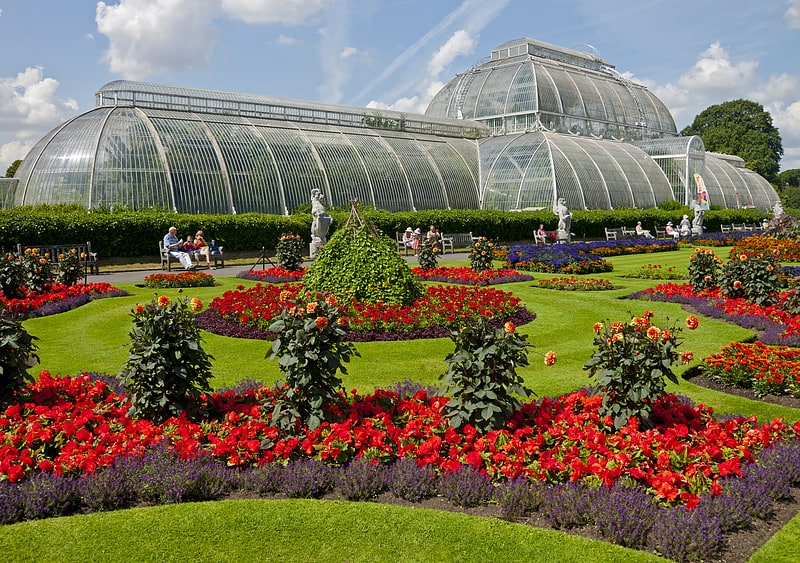
Plants from the Arctic to the Tropics. Kew Gardens is a botanic garden in southwest London that houses the "largest and most diverse botanical and mycological collections in the world". Founded in 1840, from the exotic garden at Kew Park, its living collections includes some of the 27,000 taxa curated by Royal Botanic Gardens, Kew, while the herbarium, one of the largest in the world, has over 8.5 million preserved plant and fungal specimens. The library contains more than 750,000 volumes, and the illustrations collection contains more than 175,000 prints and drawings of plants. It is one of London's top tourist attractions and is a World Heritage Site.
Kew Gardens, together with the botanic gardens at Wakehurst in Sussex, are managed by the Royal Botanic Gardens, Kew, an internationally important botanical research and education institution that employs over 1,100 staff and is a non-departmental public body sponsored by the Department for Environment, Food and Rural Affairs.
The Kew site, which has been dated as formally starting in 1759, although it can be traced back to the exotic garden at Kew Park, formed by Henry, Lord Capell of Tewkesbury, consists of 132 hectares (330 acres) of gardens and botanical glasshouses, four Grade I listed buildings, and 36 Grade II listed structures, all set in an internationally significant landscape. It is listed Grade I on the Register of Historic Parks and Gardens.
Kew Gardens has its own police force, Kew Constabulary, which has been in operation since 1847.[3]
Address: Kew Rd, TW9 3AB Kew (Richmond upon Thames)
Westminster Abbey
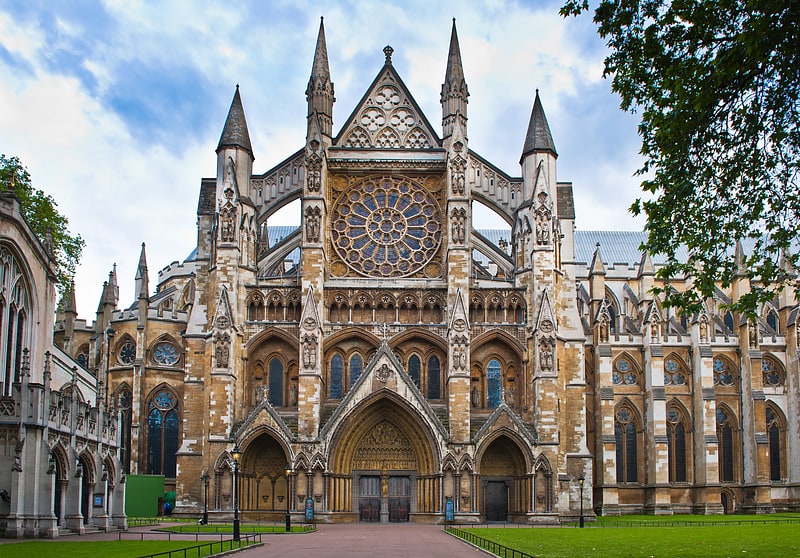
Gothic church and site for coronations. Westminster Abbey, formally titled the Collegiate Church of Saint Peter at Westminster, is a large, mainly Gothic abbey church in the City of Westminster, London, England, just to the west of the Palace of Westminster. It is one of the United Kingdom's most notable religious buildings and the traditional place of coronation and a burial site for English and, later, British monarchs.
The building itself was originally a Catholic Benedictine monastic church until the monastery was dissolved in 1539. Between 1540 and 1556, the abbey had the status of a cathedral and seat of the Catholic bishop. After 1560 the building was no longer an abbey or a cathedral, after the Catholics had been driven out by King Henry VIII, having instead been granted the status of a Church of England "Royal Peculiar"—a church responsible directly to the sovereign—by Queen Elizabeth I.
According to a tradition first reported by Sulcard in about 1080, a church was founded at the site (then known as Thorn Ey (Thorn Island)) in the seventh century at the time of Mellitus, a Bishop of London. Construction of the present church began in 1245 on the orders of King Henry III.
Since the coronation of William the Conqueror in 1066, all coronations of English and British monarchs have occurred in Westminster Abbey. Sixteen royal weddings have occurred at the Abbey since 1100.
The Abbey is the burial site of more than 3,300 people, usually of prominence in British history: at least 16 monarchs, eight prime ministers, poets laureate, actors, scientists, military leaders, and the Unknown Warrior. As such, Westminster Abbey is sometimes described as "Britain's Valhalla", after the iconic hall of the chosen heroes in Norse mythology.[4]
Address: 20 Deans Yd, SW1P 3PA London (City of Westminster)
British Museum
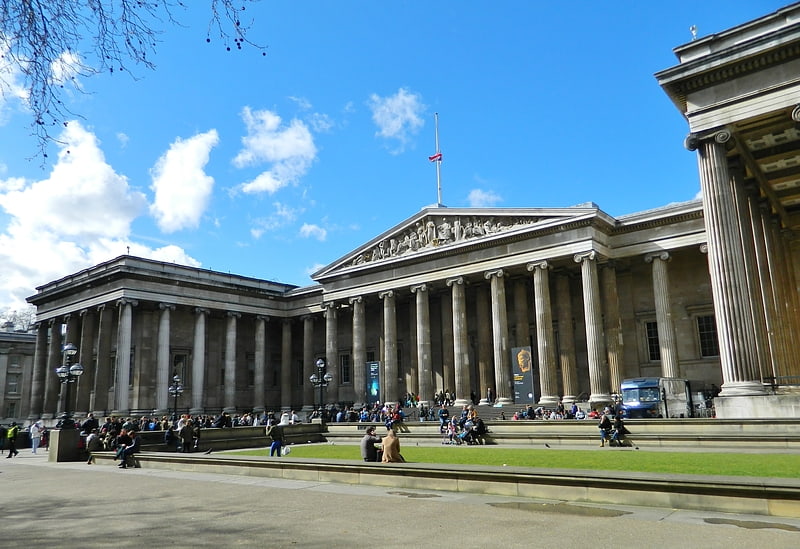
A historian's treasure trove. The British Museum is a public museum dedicated to human history, art and culture located in the Bloomsbury area of London. Its permanent collection of eight million works is among the largest and most comprehensive in existence. It documents the story of human culture from its beginnings to the present. The British Museum was the first public national museum in the world.
The Museum was established in 1753, largely based on the collections of the Anglo-Irish physician and scientist Sir Hans Sloane. It first opened to the public in 1759, in Montagu House, on the site of the current building. The museum's expansion over the following 250 years was largely a result of British colonisation and has resulted in the creation of several branch institutions, or independent spin-offs, the first being the Natural History Museum in 1881.
In 1973, the British Library Act 1972 detached the library department from the British Museum, but it continued to host the now separated British Library in the same Reading Room and building as the museum until 1997. The museum is a non-departmental public body sponsored by the Department for Digital, Culture, Media and Sport, and as with all national museums in the UK it charges no admission fee, except for loan exhibitions.
Its ownership of a small percentage of its most famous objects originating in other countries is disputed and remains the subject of international controversy through repatriation claims, most notably in the case of the Elgin Marbles of Greece, and the Rosetta Stone of Egypt.[5]
Address: Great Russell St, WC1B 3DG London (Camden)
Tate Modern
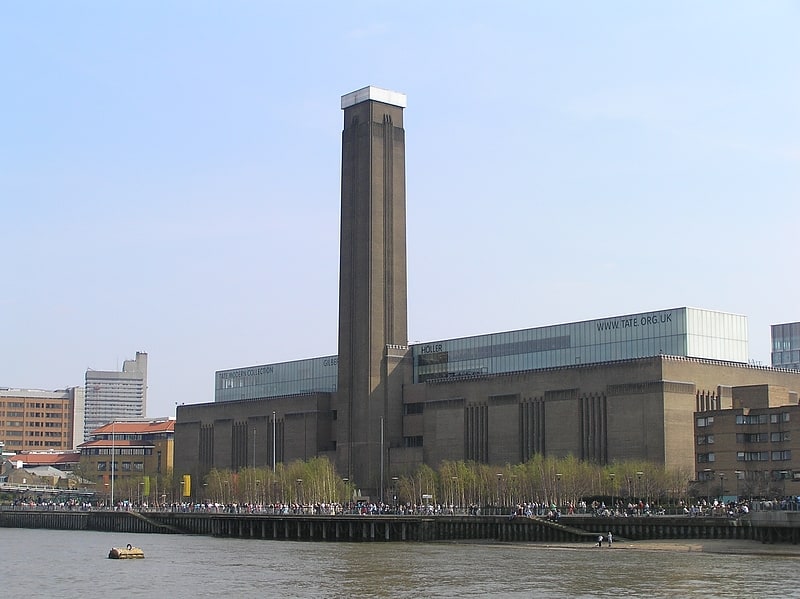
Contemporary art and cafe with river views. Tate Modern is an art gallery located in London. It houses the United Kingdom's national collection of international modern and contemporary art, and forms part of the Tate group together with Tate Britain, Tate Liverpool and Tate St Ives. It is located in the former Bankside Power Station, in the Bankside area of the London Borough of Southwark.
Tate Modern is one of the largest museums of modern and contemporary art in the world. As with the UK's other national galleries and museums, there is no admission charge for access to the collection displays, which take up the majority of the gallery space, whereas tickets must be purchased for the major temporary exhibitions. Due to the COVID-19 pandemic the museum was closed for 173 days in 2020, and attendance plunged by 77 per cent to 1,432,991 in 2020. Nonetheless, the Tate was third in the list of most-visited art museums in the world in 2020, and the most visited in Britain. The nearest railway and London Underground station is Blackfriars, which is 0.5 km from the gallery.[6]
Address: 53 Bankside, SE1 9TG London (Southwark)
Big Ben

London's iconic national timepiece. Big Ben is the nickname for the Great Bell of the striking clock at the north end of the Palace of Westminster in London, England, although the name is frequently extended to refer also to the clock and the clock tower. The official name of the tower in which Big Ben is located was originally the Clock Tower, but it was renamed Elizabeth Tower in 2012, to mark the Diamond Jubilee of Elizabeth II.
The tower was designed by Augustus Pugin in a neo-Gothic style. When completed in 1859, its clock was the largest and most accurate four-faced striking and chiming clock in the world. The tower stands 316 feet (96 m) tall, and the climb from ground level to the belfry is 334 steps. Its base is square, measuring 40 feet (12 m) on each side. Dials of the clock are 22.5 feet (6.9 m) in diameter. All four nations of the UK are represented on the tower on shields featuring a rose for England, thistle for Scotland, shamrock for Northern Ireland, and leek for Wales. On 31 May 2009, celebrations were held to mark the tower's 150th anniversary.
Big Ben is the largest of the tower's five bells and weighs 13.5 long tons (13.7 tonnes; 15.1 short tons). It was the largest bell in the United Kingdom for 23 years. The origin of the bell's nickname is open to question; it may be named after Sir Benjamin Hall, who oversaw its installation, or heavyweight boxing champion Benjamin Caunt. Four quarter bells chime at 15, 30 and 45 minutes past the hour and just before Big Ben tolls on the hour. The clock uses its original Victorian mechanism, but an electric motor can be used as a backup.
The tower is a British cultural icon recognised all over the world. It is one of the most prominent symbols of the United Kingdom and parliamentary democracy, and it is often used in the establishing shot of films set in London. The clock tower has been part of a Grade I listed building since 1970 and a UNESCO World Heritage Site since 1987.
On 21 August 2017, a four-year schedule of renovation works began on the tower. Modifications have included adding a lift, re-glazing and repainting the clock dials, and upgrading lighting and repairing roof tiles among other improvements. With a few exceptions, such as New Year's Eve and Remembrance Sunday, the bells are to be silent until the work is completed in 2022.[7]
Address: Bridge St, SW1A 2PW London (City of Westminster)
Victoria and Albert Museum
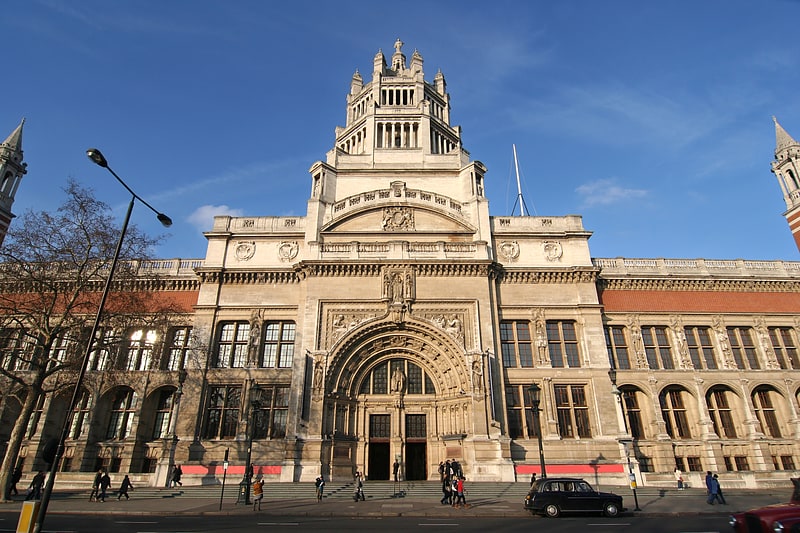
World-class decorative art and design. The Victoria and Albert Museum in London is the world's largest museum of applied arts, decorative arts, and design, housing a permanent collection of over 2.27 million objects. It was founded in 1852 and named after Queen Victoria and Prince Albert.
The V&A is located in the Royal Borough of Kensington and Chelsea, in an area known as "Albertopolis" because of its association with Prince Albert, the Albert Memorial and the major cultural institutions with which he was associated. These include the Natural History Museum, the Science Museum, the Royal Albert Hall and Imperial College London. The museum is a non-departmental public body sponsored by the Department for Digital, Culture, Media and Sport. As with other national British museums, entrance is free.
The V&A covers 12.5 acres (5.1 ha) and 145 galleries. Its collection spans 5000 years of art, from ancient times to the present day, from the cultures of Europe, North America, Asia and North Africa. However, the art of antiquity in most areas is not collected. The holdings of ceramics, glass, textiles, costumes, silver, ironwork, jewellery, furniture, medieval objects, sculpture, prints and printmaking, drawings and photographs are among the largest and most comprehensive in the world.
The museum owns the world's largest collection of post-classical sculpture, with the holdings of Italian Renaissance items being the largest outside Italy. The departments of Asia include art from South Asia, China, Japan, Korea and the Islamic world. The East Asian collections are among the best in Europe, with particular strengths in ceramics and metalwork, while the Islamic collection is amongst the largest in the Western world. Overall, it is one of the largest museums in the world.
Since 2001, the museum has embarked on a major £150m renovation programme. New 17th- and 18th-century European galleries were opened on 9 December 2015. These restored the original Aston Webb interiors and host the European collections 1600–1815. The Young V&A in East London is a branch of the museum, and a new branch in London is being planned. The first V&A museum outside London, V&A Dundee opened on 15 September 2018.[8]
Address: Cromwell Rd, SW7 2RL London (Kensington and Chelsea)
Buckingham Palace

Royal residence in London, England. Buckingham Palace is a London royal residence and the administrative headquarters of the monarch of the United Kingdom. Located in the City of Westminster, the palace is often at the centre of state occasions and royal hospitality. It has been a focal point for the British people at times of national rejoicing and mourning.
Originally known as Buckingham House, the building at the core of today's palace was a large townhouse built for the Duke of Buckingham in 1703 on a site that had been in private ownership for at least 150 years. It was acquired by King George III in 1761 as a private residence for Queen Charlotte and became known as The Queen's House. During the 19th century it was enlarged, principally by architects John Nash and Edward Blore, who constructed three wings around a central courtyard. Buckingham Palace became the London residence of the British monarch on the accession of Queen Victoria in 1837.
The last major structural additions were made in the late 19th and early 20th centuries, including the East Front, which contains the well-known balcony on which the British royal family traditionally congregates to greet crowds. A German bomb destroyed the palace chapel during the Second World War; the Queen's Gallery was built on the site and opened to the public in 1962 to exhibit works of art from the Royal Collection.
The original early-19th-century interior designs, many of which survive, include widespread use of brightly coloured scagliola and blue and pink lapis, on the advice of Sir Charles Long. King Edward VII oversaw a partial redecoration in a Belle Époque cream and gold colour scheme. Many smaller reception rooms are furnished in the Chinese regency style with furniture and fittings brought from the Royal Pavilion at Brighton and from Carlton House. The palace has 775 rooms, and the garden is the largest private garden in London. The state rooms, used for official and state entertaining, are open to the public each year for most of August and September and on some days in winter and spring.[9]
Address: Buckingham Palace Rd, SW1A 1AA London (City of Westminster)
National Maritime Museum
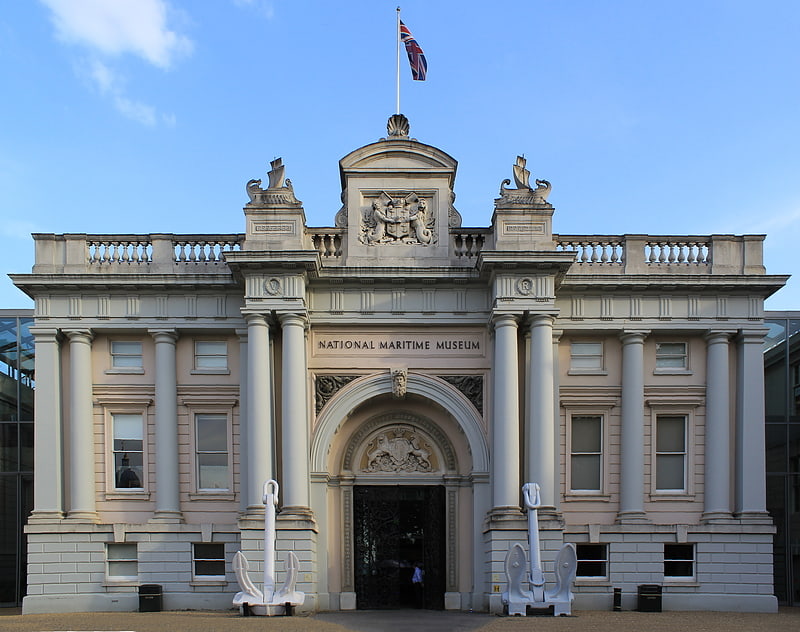
The history of Britain at sea. The National Maritime Museum is a maritime museum in Greenwich, London. It is part of Royal Museums Greenwich, a network of museums in the Maritime Greenwich World Heritage Site. Like other publicly funded national museums in the United Kingdom, it has no general admission charge; there are admission charges for most side-gallery temporary exhibitions, usually supplemented by many loaned works from other museums.[10]
Address: Park Row, SE10 9NF London (Greenwich)
Madame Tussauds
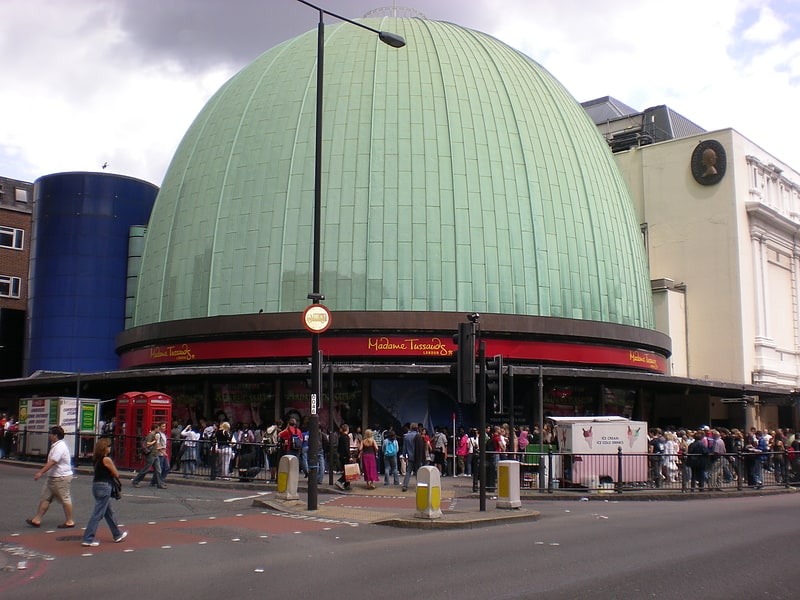
Museum. Madame Tussauds is a wax museum in London; it has smaller museums in other major cities. It was founded by wax sculptor Marie Tussaud in 1835. It used to be spelled as "Madame Tussaud's"; the apostrophe is no longer used. Madame Tussauds is a major tourist attraction in London, displaying the waxworks of famous and historical figures, as well as popular film and television characters. The nearest station to the museum is Baker Street which is at the walking distance of 120 metres.[11]
Address: Marylebone Rd, NW1 5LR London (Camden)
National Gallery

Major art from 13th to 19th centuries. The National Gallery is an art museum in Trafalgar Square in the City of Westminster, in Central London. Founded in 1824, it houses a collection of over 2,300 paintings dating from the mid-13th century to 1900.
The Gallery is an exempt charity, and a non-departmental public body of the Department for Digital, Culture, Media and Sport. Its collection belongs to the government on behalf of the British public, and entry to the main collection is free of charge. In 2020, due to the COVID-19 pandemic it attracted only 1,197,143 visitors, a drop of 50 per cent from 2019, but it still ranked eighth on the list of most-visited art museums in the world.
Unlike comparable museums in continental Europe, the National Gallery was not formed by nationalising an existing royal or princely art collection. It came into being when the British government bought 38 paintings from the heirs of John Julius Angerstein in 1824. After that initial purchase, the Gallery was shaped mainly by its early directors, especially Charles Lock Eastlake, and by private donations, which now account for two-thirds of the collection. The collection is smaller than many European national galleries, but encyclopaedic in scope; most major developments in Western painting "from Giotto to Cézanne" are represented with important works. It used to be claimed that this was one of the few national galleries that had all its works on permanent exhibition, but this is no longer the case.
The present building, the third to house the National Gallery, was designed by William Wilkins from 1832 to 1838. Only the facade onto Trafalgar Square remains essentially unchanged from this time, as the building has been expanded piecemeal throughout its history. Wilkins's building was often criticised for the perceived weaknesses of its design and for its lack of space; the latter problem led to the establishment of the Tate Gallery for British art in 1897.
The Sainsbury Wing, a 1991 extension to the west by Robert Venturi and Denise Scott Brown, is a significant example of Postmodernist architecture in Britain. The current Director of the National Gallery is Gabriele Finaldi.[12]
Address: Trafalgar Square, WC2N 5DN London (City of Westminster)
Kensington Palace
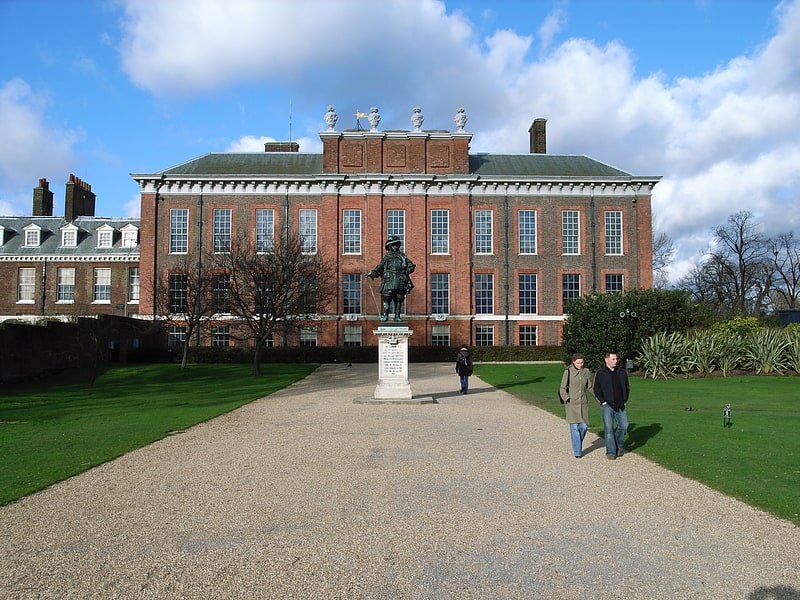
Royal museum in state residence. Kensington Palace is a royal residence set in Kensington Gardens, in the Royal Borough of Kensington and Chelsea in London, England. It has been a residence of the British royal family since the 17th century, and is currently the official London residence of the Duke and Duchess of Cambridge, the Duke and Duchess of Gloucester, the Duke and Duchess of Kent, and Prince and Princess Michael of Kent.
Today, the State Rooms are open to the public and managed by the independent charity Historic Royal Palaces, a nonprofit organisation that does not receive public funds. The offices and private accommodation areas of the Palace remain the responsibility of the Royal Household and are maintained by the Royal Household Property Section. The palace also displays many paintings and other objects from the Royal Collection.[13]
Address: Kensington Gardens, W8 4PX Kensington (Kensington and Chelsea)
Royal Observatory

Astronomy centre on the Prime Meridian. The Royal Observatory, Greenwich is an observatory situated on a hill in Greenwich Park in south east London, overlooking the River Thames to the north. It played a major role in the history of astronomy and navigation, and because the Prime Meridian passes through it, it gave its name to Greenwich Mean Time, the precursor to today's Coordinated Universal Time. The ROG has the IAU observatory code of 000, the first in the list. ROG, the National Maritime Museum, the Queen's House and the clipper ship Cutty Sark are collectively designated Royal Museums Greenwich.
The observatory was commissioned in 1675 by King Charles II, with the foundation stone being laid on 10 August. The site was chosen by Sir Christopher Wren, a former Savilian Professor of Astronomy; as Greenwich Park was a royal estate, no new land needed to be bought. At that time the king also created the position of Astronomer Royal, to serve as the director of the observatory and to "apply himself with the most exact care and diligence to the rectifying of the tables of the motions of the heavens, and the places of the fixed stars, so as to find out the so much desired longitude of places for the perfecting of the art of navigation." He appointed John Flamsteed as the first Astronomer Royal. The building was completed in the summer of 1676. The building was often called "Flamsteed House", in reference to its first occupant.
The scientific work of the observatory was relocated elsewhere in stages in the first half of the 20th century, and the Greenwich site is now maintained almost exclusively as a museum, although the AMAT telescope became operational for astronomical research in 2018.[14]
Address: Blackheath Ave, SE10 8XJ London (Greenwich)
Natural History Museum
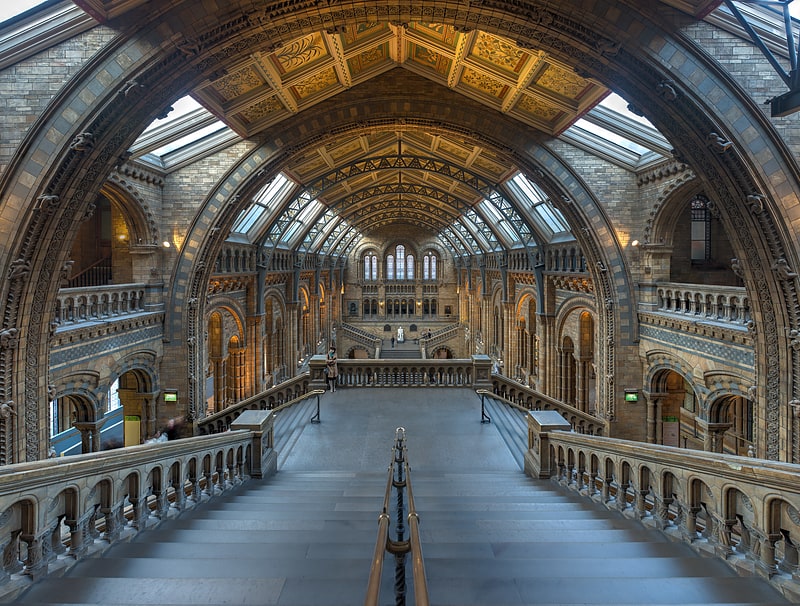
Natural phenomena and hands-on activities. The Natural History Museum in London is a natural history museum that exhibits a vast range of specimens from various segments of natural history. It is one of three major museums on Exhibition Road in South Kensington, the others being the Science Museum and the Victoria and Albert Museum. The Natural History Museum's main frontage, however, is on Cromwell Road.
The museum is home to life and earth science specimens comprising some 80 million items within five main collections: botany, entomology, mineralogy, palaeontology and zoology. The museum is a centre of research specialising in taxonomy, identification and conservation. Given the age of the institution, many of the collections have great historical as well as scientific value, such as specimens collected by Charles Darwin. The museum is particularly famous for its exhibition of dinosaur skeletons and ornate architecture—sometimes dubbed a cathedral of nature—both exemplified by the large Diplodocus cast that dominated the vaulted central hall before it was replaced in 2017 with the skeleton of a blue whale hanging from the ceiling. The Natural History Museum Library contains extensive books, journals, manuscripts, and artwork collections linked to the work and research of the scientific departments; access to the library is by appointment only. The museum is recognised as the pre-eminent centre of natural history and research of related fields in the world.
Although commonly referred to as the Natural History Museum, it was officially known as British Museum (Natural History) until 1992, despite legal separation from the British Museum itself in 1963. Originating from collections within the British Museum, the landmark Alfred Waterhouse building was built and opened by 1881 and later incorporated the Geological Museum. The Darwin Centre is a more recent addition, partly designed as a modern facility for storing the valuable collections.
Like other publicly funded national museums in the United Kingdom, the Natural History Museum does not charge an admission fee. The museum is an exempt charity and a non-departmental public body sponsored by the Department for Digital, Culture, Media and Sport. Catherine, Duchess of Cambridge, is a patron of the museum. There are approximately 850 staff at the museum. The two largest strategic groups are the Public Engagement Group and Science Group.[15]
Address: Cromwell Rd, SW7 5BD London (Kensington and Chelsea)
Tower Bridge
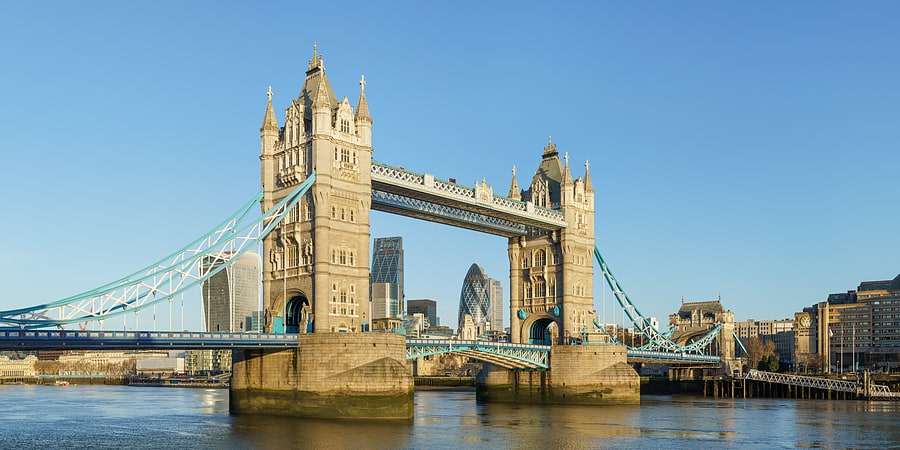
Iconic Victorian turreted bridge. Tower Bridge is a Grade I listed combined bascule and suspension bridge in London, built between 1886 and 1894, designed by Horace Jones and engineered by John Wolfe Barry with the help of Henry Marc Brunel. The bridge crosses the River Thames close to the Tower of London and is one of five London bridges owned and maintained by the Bridge House Estates, a charitable trust founded in 1282. The bridge was constructed to give better access to the East End of London, which had expanded its commercial potential in the 19th century. The bridge was opened by Edward, Prince of Wales and Alexandra, Princess of Wales in 1894.
The bridge is 800 feet (240 m) in length and consists of two 213-foot (65 m) bridge towers connected at the upper level by two horizontal walkways, and a central pair of bascules that can open to allow shipping. Originally hydraulically powered, the operating mechanism was converted to an electro-hydraulic system in 1972. The bridge is part of the A100 London Inner Ring Road and thus the boundary of the London congestion charge zone, and remains an important traffic route with 40,000 crossings every day. The bridge deck is freely accessible to both vehicles and pedestrians, whereas the bridge's twin towers, high-level walkways and Victorian engine rooms form part of the Tower Bridge Exhibition.
Tower Bridge has become a recognisable London landmark. It is sometimes confused with London Bridge, about 0.5 miles (0.80 km) upstream, which has led to a popular urban legend about an American purchasing the wrong bridge. Several stunt pilots have flown underneath the bridge, including the pioneering Francis McClean.[16]
Address: Tower Bridge Rd, SE1 2UP London (Southwark)
Tate Britain

Art gallery in London, England. Tate Britain, known from 1897 to 1932 as the National Gallery of British Art and from 1932 to 2000 as the Tate Gallery, is an art museum on Millbank in the City of Westminster in London, England. It is part of the Tate network of galleries in England, with Tate Modern, Tate Liverpool and Tate St Ives. It is the oldest gallery in the network, having opened in 1897. It houses a substantial collection of the art of the United Kingdom since Tudor times, and in particular has large holdings of the works of J. M. W. Turner, who bequeathed all his own collection to the nation. It is one of the largest museums in the country. The museum had 391,595 visitors in 2020, a drop of 78 per cent from 2019 due to COVID-19 pandemic closures, but still ranked 52nd on the list of most-visited art museums in the world.[17]
Address: Millbank, SW1P 4RG, London, London (City of Westminster)
Hampton Court Palace

Henry VIII's royal palace and grounds. Hampton Court Palace is a Grade I listed royal palace in the London Borough of Richmond upon Thames, 12 miles south west and upstream of central London on the River Thames. The building of the palace began in 1514 for Cardinal Thomas Wolsey, the chief minister of King Henry VIII. In 1529, as Wolsey fell from favour, the cardinal gave the palace to the king to check his disgrace. The palace went on to become one of Henry's most favoured residences; soon after acquiring the property, he arranged for it to be enlarged so that it might more easily accommodate his sizeable retinue of courtiers. Along with St James' Palace, it is one of only two surviving palaces out of the many the king owned. The palace is currently in the possession of Queen Elizabeth II and the Crown.
In the following century, King William III's massive rebuilding and expansion work, which was intended to rival the Palace of Versailles, destroyed much of the Tudor palace. His work ceased in 1694, leaving the palace in two distinct contrasting architectural styles, domestic Tudor and Baroque. While the palace's styles are an accident of fate, a unity exists due to the use of pink bricks and a symmetrical, if vague, balancing of successive low wings. King George II was the last monarch to reside in the palace.
Today, the palace is open to the public and a major tourist attraction, easily reached by train from Waterloo station in central London and served by Hampton Court railway station in East Molesey, in Transport for London's Zone 6. In addition, London Buses routes 111, 216, 411 and R68 stop outside the palace gates. The structure and grounds are cared for by an independent charity, Historic Royal Palaces, which receives no funding from the Government or the Crown. In addition, the palace displays many works of art from the Royal Collection.
Apart from the Palace itself and its gardens, other points of interest for visitors include the celebrated maze, the historic royal tennis court (see below), and the huge grape vine, the largest in the world as of 2005. The palace's Home Park is the site of the annual Hampton Court Palace Festival and Hampton Court Garden Festival.[18]
Address: Hampton Court Rd, KT8 9AU Hampton (Richmond upon Thames)
London Dungeon
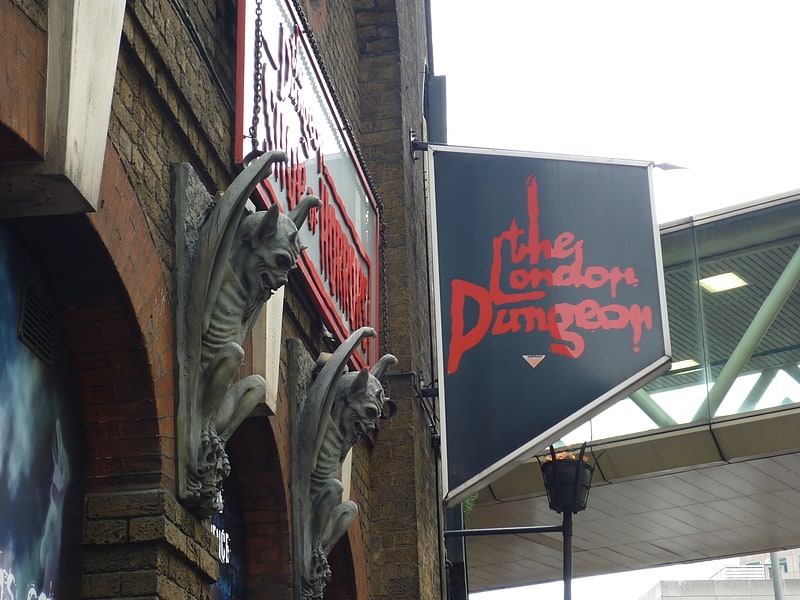
Hi-tech haunted house attraction. The London Dungeon is a tourist attraction along London's South Bank, England, which recreates various gory and macabre historical events in a gallows humour style. It uses a mixture of live actors, special effects and rides.[19]
Address: Westminster Bridge Rd, SE1 7PB London (Lambeth)
Royal Academy of Arts

Art gallery in London, England. The Royal Academy of Arts is an art institution based in Burlington House on Piccadilly in London. Founded in 1768, it has a unique position as an independent, privately funded institution led by eminent artists and architects. Its purpose is to promote the creation, enjoyment and appreciation of the visual arts through exhibitions, education and debate.[20]
Address: Burlington House Piccadilly, W1J 0BD London (City of Westminster)
Science Museum
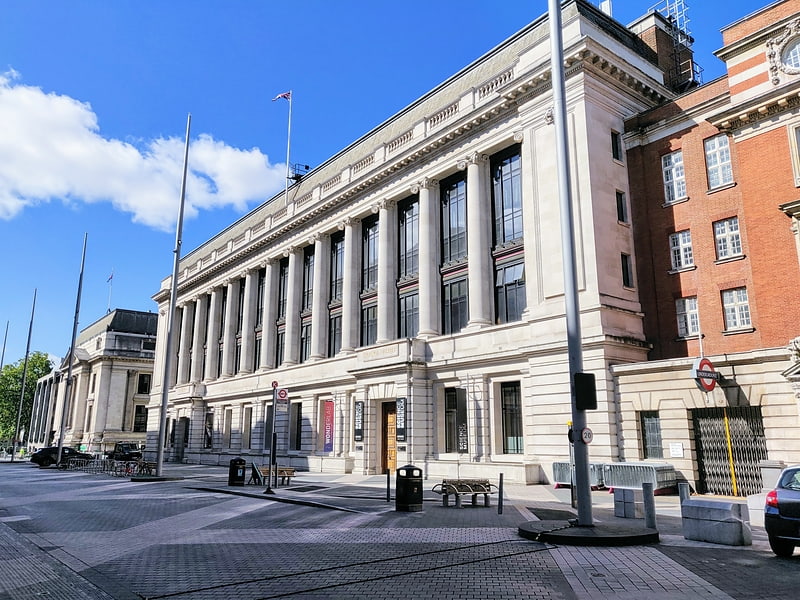
Hands-on exhibits in dozens of galleries. The Science Museum is a major museum on Exhibition Road in South Kensington, London. It was founded in 1857 and to date is one of the city's major tourist attractions, attracting 3.3 million visitors annually.
Like other publicly funded national museums in the United Kingdom, the Science Museum does not charge visitors for admission, although visitors are requested to make a donation if they are able. Temporary exhibitions may incur an admission fee.
It is one of the five museums in the Science Museum Group.[21]
Address: Exhibition Rd, SW7 2DD London (Kensington and Chelsea)
Hyde Park
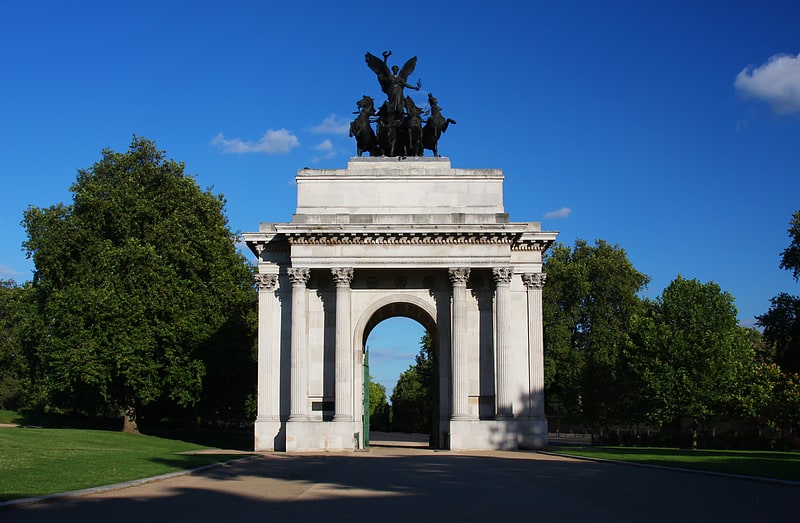
Acres of greenery in Central London. Hyde Park is a Grade I-listed major park in Central London. It is the largest of four Royal Parks that form a chain from the entrance of Kensington Palace through Kensington Gardens and Hyde Park, via Hyde Park Corner and Green Park past the main entrance to Buckingham Palace. The park is divided by the Serpentine and the Long Water lakes.
The park was established by Henry VIII in 1536 when he took the land from Westminster Abbey and used it as a hunting ground. It opened to the public in 1637 and quickly became popular, particularly for May Day parades. Major improvements occurred in the early 18th century under the direction of Queen Caroline. Several duels took place in Hyde Park during this time, often involving members of the nobility. The Great Exhibition of 1851 was held in the park, for which The Crystal Palace, designed by Joseph Paxton, was erected.
Free speech and demonstrations have been a key feature of Hyde Park since the 19th century. Speakers' Corner has been established as a point of free speech and debate since 1872, while the Chartists, the Reform League, the suffragettes, and the Stop the War Coalition have all held protests there. In the late 20th century, the park was known for holding large-scale free rock music concerts, featuring groups such as Pink Floyd, The Rolling Stones and Queen. Major events in the park have continued into the 21st century, such as Live 8 in 2005, and the annual Hyde Park Winter Wonderland from 2007.[22]
Address: Serpentine Rd, W2 2TP London (City of Westminster)
Saatchi Gallery
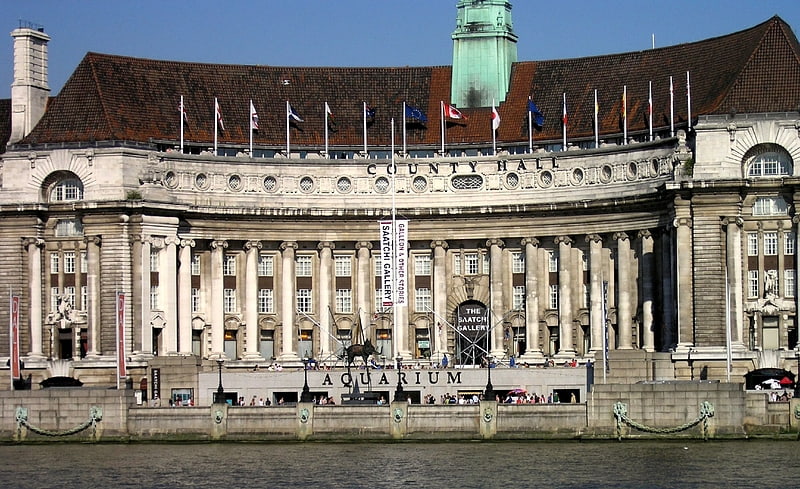
Art gallery in London, England. The Saatchi Gallery is a London gallery for contemporary art and an independent charity opened by Charles Saatchi in 1985. Exhibitions which drew upon the collection of Charles Saatchi, starting with US artists and minimalism, moving to the Damien Hirst-led Young British Artists, followed by shows purely of painting, led to Saatchi Gallery becoming a recognised authority in contemporary art globally. It has occupied different premises, first in North London, then the South Bank by the River Thames, and finally in Chelsea, Duke of York's HQ, its current location. In 2019 Saatchi Gallery became a registered charity and begun a new chapter in its history. Recent exhibitions include the major solo exhibition of the artist JR, JR: Chronicles, and London Grads Now in September 2019 lending the gallery spaces to graduates from leading fine art schools who experienced the cancellation of physical degree shows due to the pandemic.
The gallery's mission is to support artists and render contemporary art accessible to all by presenting projects in physical and digital spaces that are engaging, enlightening and educational for diverse audiences. The Gallery presents curated exhibitions on themes relevant and exciting in the context of contemporary creative culture. Its educational programmes aim to reveal the possibilities of artistic expression to young minds, encourage fresh thought and stimulate innovation.
In 2019, Saatchi Gallery transitioned to becoming a charitable organisation, relying upon private donations to reinvest its revenue into its core learning activities and to support access to contemporary art for all.[23]
Address: King's Rd, SW3 4RY London (Kensington and Chelsea)
Churchill War Rooms
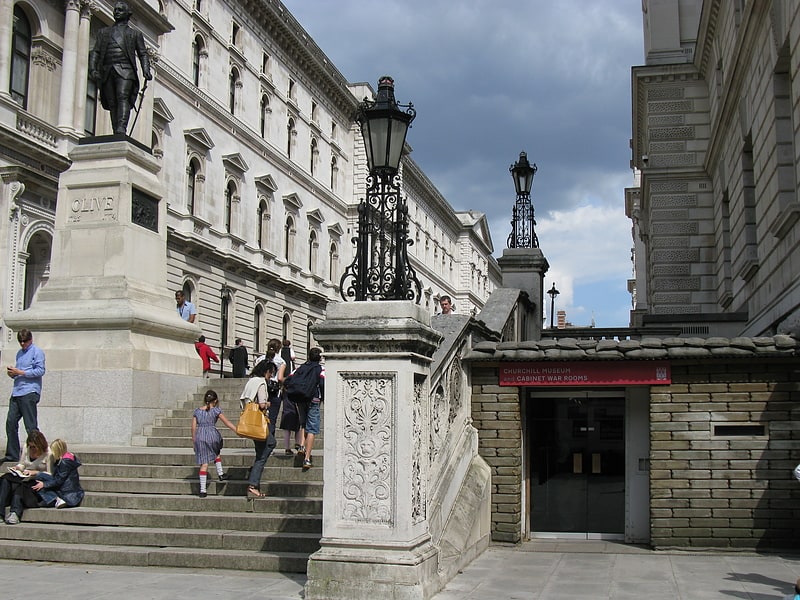
Churchill's WWII underground offices. The Churchill War Rooms is a museum in London and one of the five branches of the Imperial War Museum. The museum comprises the Cabinet War Rooms, a historic underground complex that housed a British government command centre throughout the Second World War, and the Churchill Museum, a biographical museum exploring the life of British statesman Winston Churchill.
Construction of the Cabinet War Rooms, located beneath the Treasury building in the Whitehall area of Westminster, began in 1938. They became fully operational on 27 August 1939, a week before Britain declared war on Germany. The War Rooms remained in operation throughout the Second World War, before being abandoned in August 1945 after the surrender of Japan.
After the war, the historic value of the Cabinet War Rooms was recognised. Their preservation became the responsibility of the Ministry of Works and later the Department for the Environment, during which time very limited numbers of the public were able to visit by appointment. In the early 1980s, the Imperial War Museum was asked to take over the administration of the site, and the Cabinet War Rooms were opened to the public in April 1984. The museum was reopened in 2005 following a major redevelopment as the Churchill Museum and Cabinet War Rooms, but in 2010 this title was shortened to the Churchill War Rooms.[24]
Address: King Charles St, SW1A 2AQ London (City of Westminster)
Parliament Square
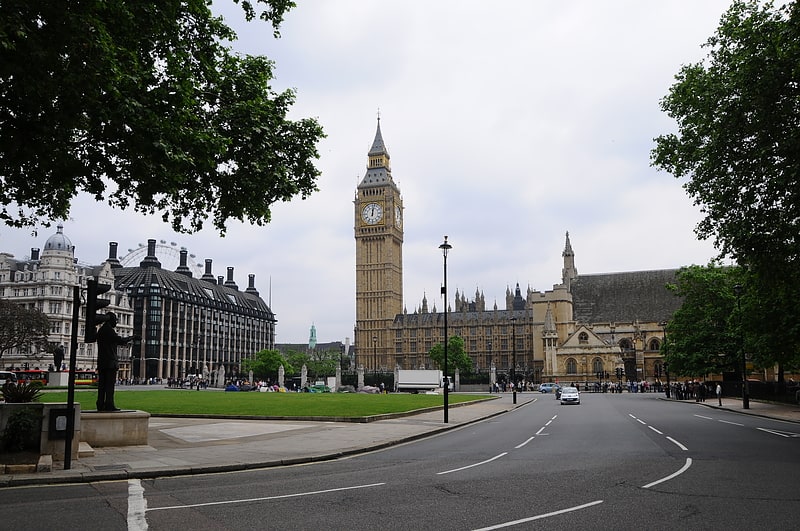
Parliament Square is a square at the northwest end of the Palace of Westminster in the City of Westminster in central London. Laid out in the 19th century, it features a large open green area in the centre with trees to its west, and it contains twelve statues of statesmen and other notable individuals.
As well as being one of London's main tourist attractions, it is also the place where many demonstrations and protests have been held. The square is overlooked by various official buildings: legislature to the east (in the Houses of Parliament), executive offices to the north (on Whitehall), the judiciary to the west (the Supreme Court), and the church to the south (with Westminster Abbey).[25]
Address: Parliament Square, SW1P London (City of Westminster)
Trafalgar Square
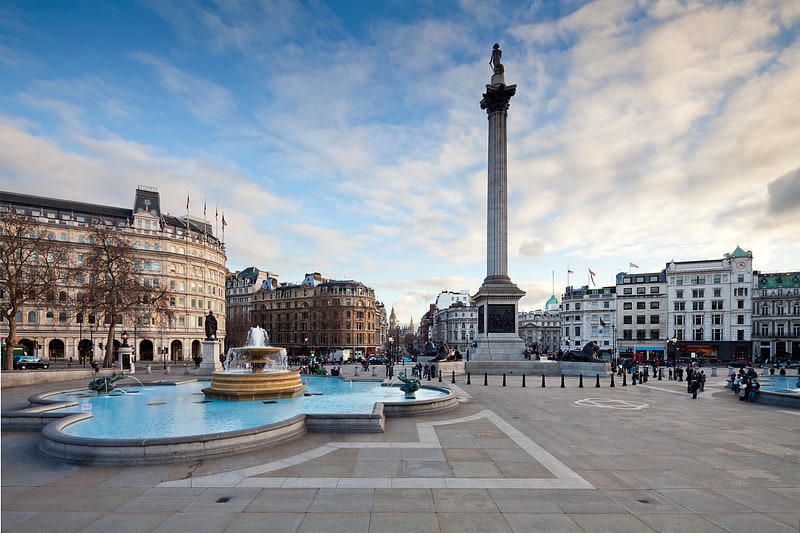
Plaza in London, England. Trafalgar Square is a public square in the City of Westminster, Central London, established in the early 19th century around the area formerly known as Charing Cross. The Square's name commemorates the Battle of Trafalgar, the British naval victory in the Napoleonic Wars over France and Spain that took place on 21 October 1805 off the coast of Cape Trafalgar.
The site around Trafalgar Square had been a significant landmark since the 1200s. For centuries, distances measured from Charing Cross have served as location markers. The site of the present square formerly contained the elaborately designed, enclosed courtyard, King's Mews. After George IV moved the mews to Buckingham Palace, the area was redeveloped by John Nash, but progress was slow after his death, and the square did not open until 1844. The 169-foot (52 m) Nelson's Column at its centre is guarded by four lion statues. A number of commemorative statues and sculptures occupy the square, but the Fourth Plinth, left empty since 1840, has been host to contemporary art since 1999. Prominent buildings facing the square include the National Gallery, St Martin-in-the-Fields, Canada House, and South Africa House.
The square has been used for community gatherings and political demonstrations, including Bloody Sunday in 1887, the culmination of the first Aldermaston March, anti-war protests, and campaigns against climate change. A Christmas tree has been donated to the square by Norway since 1947 and is erected for twelve days before and after Christmas Day. The square is a centre of annual celebrations on New Year's Eve. It was well known for its feral pigeons until their removal in the early 21st century.[26]
Address: Trafalgar Square, WC2N 5DN London (City of Westminster)
Victoria Memorial
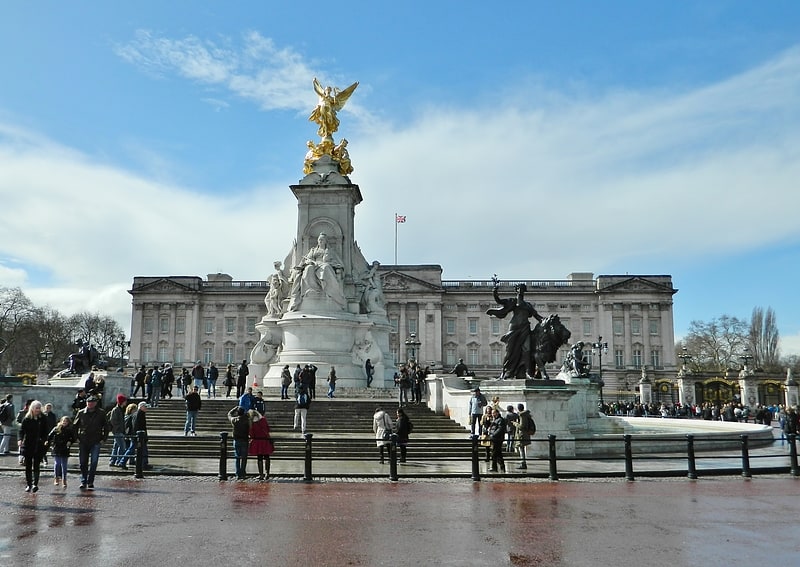
Sculpture by Aston Webb and Thomas Brock. The Victoria Memorial is a monument to Queen Victoria, located at the end of The Mall in London, and designed and executed by the sculptor Thomas Brock. Designed in 1901, it was unveiled on 16 May 1911, though it was not completed until 1924. It was the centrepiece of an ambitious urban planning scheme, which included the creation of the Queen’s Gardens to a design by Sir Aston Webb, and the refacing of Buckingham Palace by the same architect.
Like the earlier Albert Memorial in Kensington Gardens, commemorating Victoria's consort, the Victoria Memorial has an elaborate scheme of iconographic sculpture. The central pylon of the memorial is of Pentelic marble, and individual statues are in Lasa marble and gilt bronze. The memorial weighs 2,300 metric tonnes (about 2535 U.S. tons) and is 104 ft wide. In 1970 it was listed at Grade I.[27]
Address: The Mall, SW1A 1AA London (City of Westminster)
ZSL London Zoo
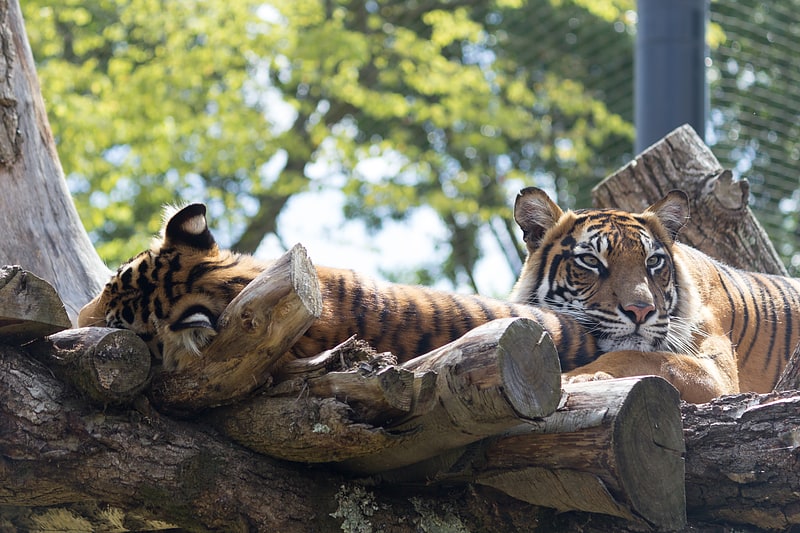
Zoo in London, England. London Zoo is the world's oldest scientific zoo. It was opened in London on 27 April 1828, and was originally intended to be used as a collection for scientific study. In 1831 or 1832, the animals of the Tower of London menagerie were transferred to the zoo's collection. It was opened to the public in 1847. Today, it houses a collection of 673 species of animals, with 19,289 individuals, making it one of the largest collections in the United Kingdom. The zoo is sometimes called Regent's Zoo.
It is managed under the aegis of the Zoological Society of London (established in 1826), and is situated at the northern edge of Regent's Park, on the boundary line between the City of Westminster and the borough of Camden (the Regent's Canal runs through it). The Society also has a more spacious site at ZSL Whipsnade Zoo in Bedfordshire to which the larger animals such as elephants and rhinos have been moved. As well as being the first scientific zoo, ZSL London Zoo also opened the first reptile house (1849), first public aquarium (1853), first insect house (1881) and the first children's zoo (1938).
ZSL receives no state funding and relies on 'Fellows' and 'Friends' memberships, entrance fees and sponsorship to generate income.[28]
Address: Outer Cir, NW1 4RY London (Camden)
Museum of the Home

Museum in London, England. The Museum of the Home, formerly the Geffrye Museum, is a museum in the 18th-century Grade I-listed former almshouses on Kingsland Road in Shoreditch, London. It explores home and home life from 1600 to the present day with galleries which ask questions about 'home', explore lived experiences, and examine the psychological and emotional relationships people have with the idea of 'home' alongside a series of period room displays. In 2018 the museum had about 120,000 visitors before then closing for two and a half years, during which an extensive refurbishment and building programme took place.The Museum reopened as the Museum of the Home in Summer 2021 with a mission to reveal and rethink the ways we live, in order to live better together, and with 80 per cent more exhibition space for its collections and 50 per cent more public space. The Museum of the Home now has new basement galleries, a cafe, learning pavilion, collections and reference libraries, and several events spaces.[29]
Address: 136 Kingsland Rd, E2 8EA, London (Hackney)
St. James's Park
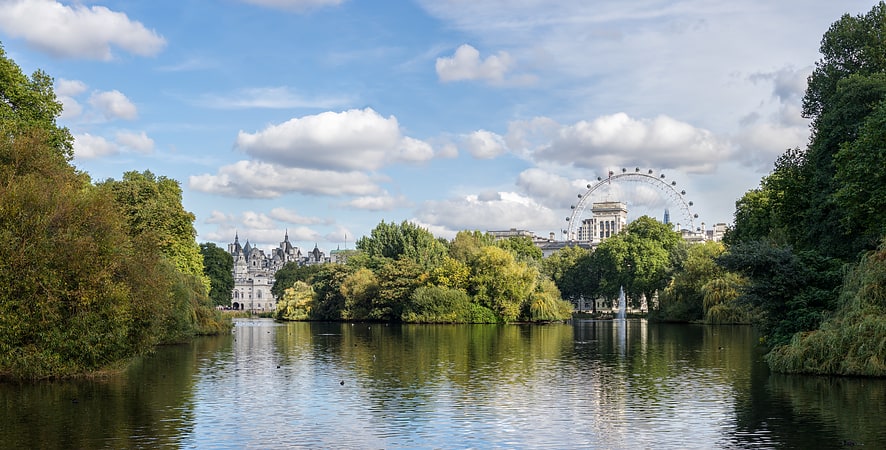
Royal park hosting Trooping the Colour. St James's Park is a 23-hectare park in the City of Westminster, central London. It is at the southernmost tip of the St James's area, which was named after a leper hospital dedicated to St James the Less. It is the most easterly of a near-continuous chain of parks that includes Green Park, Hyde Park, and Kensington Gardens.
The park is bounded by Buckingham Palace to the west, the Mall to the north, Horse Guards to the east, and Birdcage Walk to the south. It meets Green Park at Queen's Gardens with the Victoria Memorial at its centre, opposite the entrance to Buckingham Palace. St James's Palace is on the opposite side of The Mall. The closest London Underground stations are St James's Park, Green Park, Victoria, and Westminster.
The park is Grade I listed on the Register of Historic Parks and Gardens.[30]
Address: Horse Guards Road, SW1A 2BJ London (City of Westminster)
Regent's Park
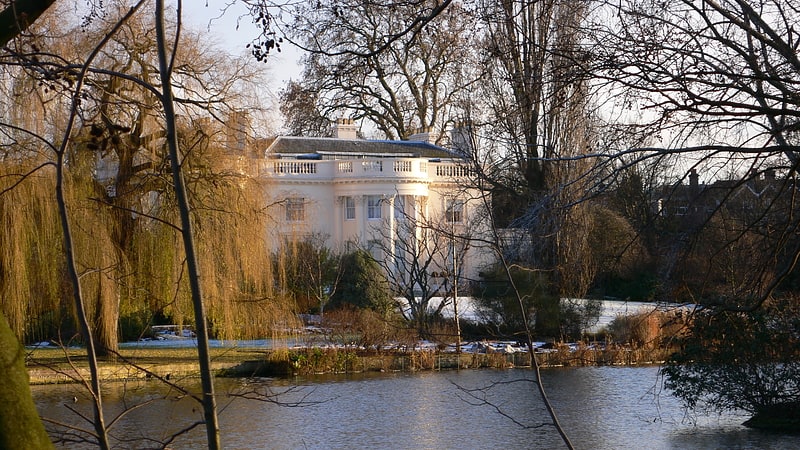
Cafe and sport centre with changing rooms. Regent's Park is one of the Royal Parks of London. It occupies high ground in north-west Inner London, administratively split between the City of Westminster and the Borough of Camden. In addition to its large central parkland and ornamental lake, it contains various structures and organizations both public and private, generally on its periphery, including Regent's University and London Zoo.
What is now Regent's Park came into possession of the Crown upon the dissolution of the monasteries in the 1500s, and was used for hunting and tenant farming. In the early 1800s, the Prince Regent proposed turning it into a pleasure garden. The Park was designed by John Nash and James and Decimus Burton. Its construction was financed privately by James after the Crown Estate rescinded its pledge to do so, and included development on the periphery of townhouses and expensive terrace dwellings. The park is Grade I listed on the Register of Historic Parks and Gardens.[31]
Address: Regent's Park, London (Camden)
St Paul's Cathedral
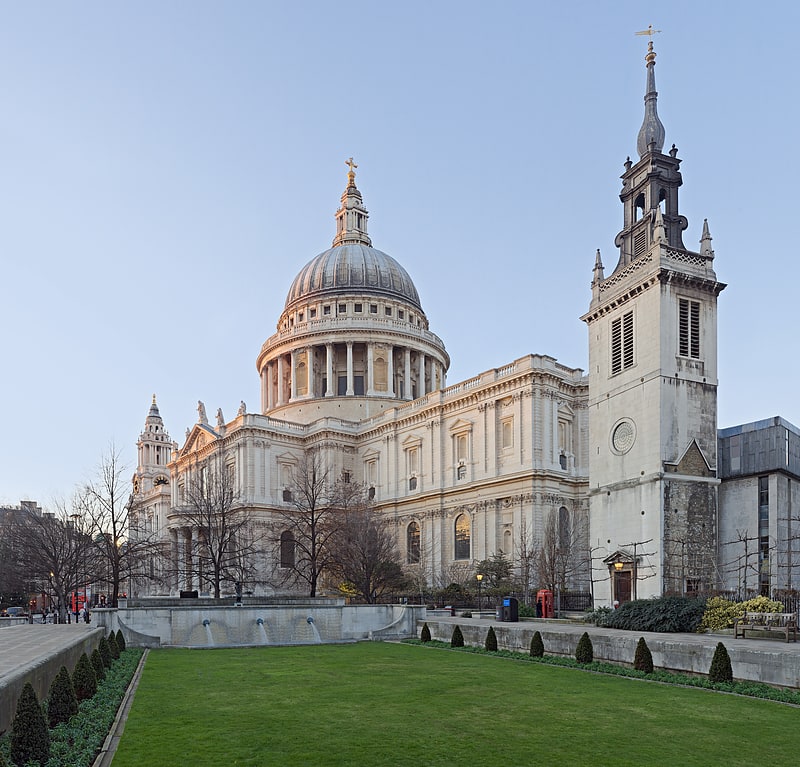
Iconic cathedral's churchyard and garden. St Paul's Cathedral is an Anglican cathedral in London. As the seat of the Bishop of London, the cathedral serves as the mother church of the Diocese of London. It is on Ludgate Hill at the highest point of the City of London and is a Grade I listed building. Its dedication to Paul the Apostle dates back to the original church on this site, founded in AD 604. The present structure, dating from the late 17th century, was designed in the English Baroque style by Sir Christopher Wren. Its construction, completed in Wren's lifetime, was part of a major rebuilding programme in the city after the Great Fire of London. The earlier Gothic cathedral, largely destroyed in the Great Fire, was a central focus for medieval and early modern London, including Paul's walk and St Paul's Churchyard, being the site of St Paul's Cross.
The cathedral is one of the most famous and most recognisable sights of London. Its dome, framed by the spires of Wren's City churches, has dominated the skyline for over 300 years. At 365 feet (111 m) high, it was the tallest building in London from 1710 to 1963. The dome remains among the highest in the world. St Paul's is the second-largest church building in area in the United Kingdom after Liverpool Cathedral.
Services held at St Paul's have included the funerals of Admiral Lord Nelson, the Duke of Wellington, Winston Churchill and Margaret Thatcher; jubilee celebrations for Queen Victoria; an inauguration service for the Metropolitan Hospital Sunday Fund; peace services marking the end of the First and Second World Wars; the wedding of Prince Charles and Lady Diana Spencer; the launch of the Festival of Britain; and the thanksgiving services for the Silver, Golden and Diamond Jubilees and the 80th and 90th birthdays of Queen Elizabeth II. St Paul's Cathedral is the central subject of much promotional material, as well as of images of the dome surrounded by the smoke and fire of the Blitz. The cathedral is a working church with hourly prayer and daily services. The tourist entry fee at the door is £20 for adults (August 2020, cheaper if booked online), but no charge is made to worshippers attending advertised services.
The nearest underground station is St Paul's, which is 130 yards (120 m) away from St Paul's Cathedral.[32]
Address: St Paul's Churchyard, EC4M 8AD London (City of London)
Oxford Street
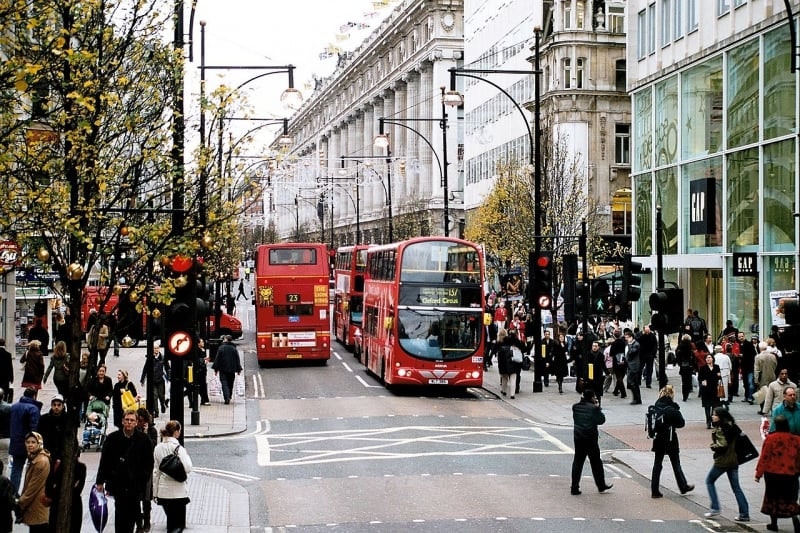
Road in London, England. Oxford Street is a major road in the City of Westminster in the West End of London, running from Tottenham Court Road to Marble Arch via Oxford Circus. It is Europe's busiest shopping street, with around half a million daily visitors, and as of 2012 had approximately 300 shops. It is designated as part of the A40, a major road between London and Fishguard, though it is not signed as such, and traffic is regularly restricted to buses and taxis.
The road was originally part of the Via Trinobantina, a Roman road between Essex and Hampshire via London. It was known as Tyburn Road through the Middle Ages when it was notorious for public hangings of prisoners at Tyburn Gallows. It became known as Oxford Road and then Oxford Street in the 18th century, and began to change from residential to commercial and retail use by the late 19th century, attracting street traders, confidence tricksters and prostitution. The first department stores in the UK opened in the early 20th century, including Selfridges, John Lewis & Partners and HMV. Unlike nearby shopping streets such as Bond Street, it has retained an element of downmarket trading alongside more prestigious retail stores. The street suffered heavy bombing during World War II, and several longstanding stores including John Lewis & Partners were completely destroyed and rebuilt from scratch.
Despite competition from other shopping centres such as Westfield Stratford City and the Brent Cross Shopping Centre, Oxford Street remains in high demand as a retail location, with several chains having their flagship stores on the street, and has a number of listed buildings. The annual switching on of Christmas lights by a celebrity has been a popular event since 1959. As a popular retail area and main thoroughfare for London buses and taxis, Oxford Street has suffered from traffic congestion, pedestrian congestion, a poor safety record and pollution. Various traffic management schemes have been implemented by Transport for London (TfL), including a ban on private vehicles during daytime hours on weekdays and Saturdays, and improved pedestrian crossings.[33]
Address: Oxford Street, W1W 8LG London (City of Westminster)
Borough Market
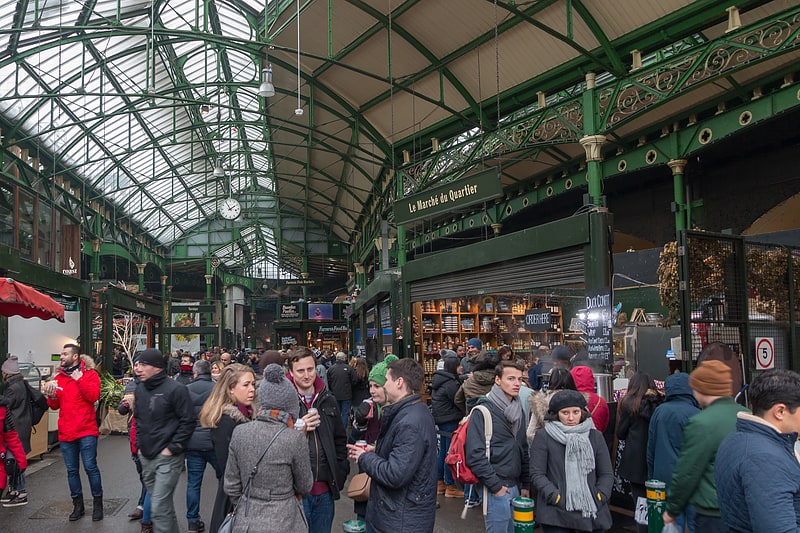
Building in London, England. Borough Market is a wholesale and retail market hall in Southwark, London, England. It is one of the largest and oldest food markets in London, with a market on the site dating back to at least the 12th century. The present buildings were built in the 1850s, and today the market mainly sells specialty foods to the general public.[34]
Address: Cathedral St, SE1 9AL London (Southwark)
Westminster Bridge
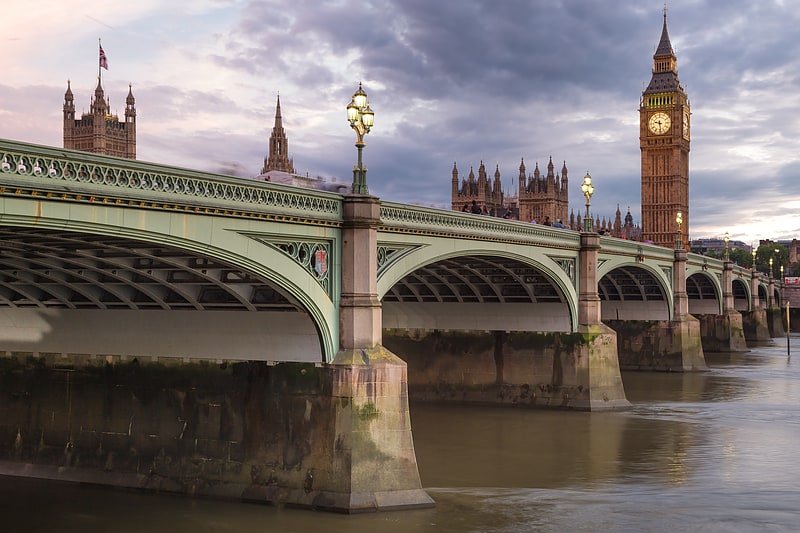
Arch bridge in London, United Kingdom. Westminster Bridge is a road-and-foot-traffic bridge over the River Thames in London, linking Westminster on the west side and Lambeth on the east side.
The bridge is painted predominantly green, the same colour as the leather seats in the House of Commons which is on the side of the Palace of Westminster nearest to the bridge, but a natural shade similar to verdigris. This is in contrast to Lambeth Bridge, which is red, the same colour as the seats in the House of Lords and is on the opposite side of the Houses of Parliament.
In 2005–2007, it underwent a complete refurbishment, including replacing the iron fascias and repainting the whole bridge. It links the Palace of Westminster on the west side of the river with County Hall and the London Eye on the east and was the finishing point during the early years of the London Marathon.
The next bridge downstream is the Hungerford Bridge & Golden Jubilee Bridges and upstream is Lambeth Bridge. Westminster Bridge was designated a Grade II* listed structure in 1981.[35]
Address: Westminster Bridge Rd., SE1 7XB London (Lambeth)